How to fit Vertical Blinds
Vertical blinds are an excellent choice for both homes and offices, providing a sleek solution to concerns about light and privacy while allowing for optimal air flow through the room.
What do I need to fit?
Tailored to your measurements, our straightforward fitting guide will walk you through each step of the process. You’ll have your vertical blinds installed in no time at all, effortlessly enhancing your space!
- Pencil: For marking the placements of your brackets on the wall or window frame.
- Screwdriver or power drill: To efficiently install the brackets and screws.
- Measuring tape: To accurately measure the positions for bracket placements.
- Appropriate screws and wall plugs: Ensure you have the correct fittings suitable for the surface you’re mounting the blinds onto. Whether it’s plaster, wood, or steel, it’s advisable to research and select the best fittings for your specific blind installation.

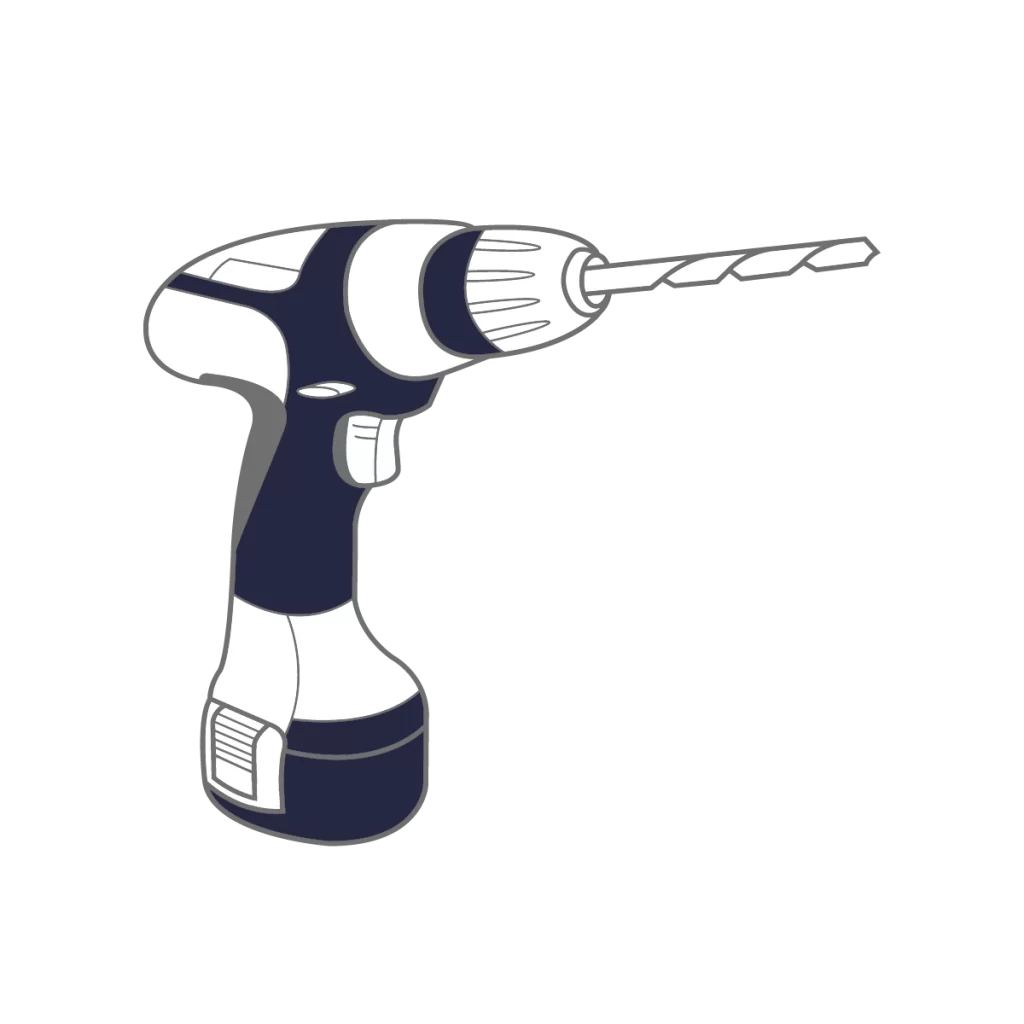



- The headrail & box of vanes*.
- Top fix & face fix brackets.
- Weights and connector chain.
- Child-safety clip for your wall.
- Screws for the safety device (if chain controlled).


- The headrail & box of vanes*.
- Top fix & face fix brackets.
- Weights and connector chain.
- Child-safety clip for your wall.
- Screws for the safety device (if chain controlled).



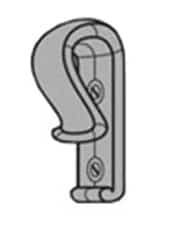
Safety Clips – These can vary in appearance

Fitting your blinds
Begin by determining how you want to fit the blind. You have the option to either top fix it, also known as ceiling fix, or face fix it. Opting to fit it within a recess helps minimize the light bleed that may occur around the edges of the blind and its material. Choose the method that best suits your preferences and space requirements.
When fitting the brackets, it’s essential to use screws and/or wall plugs that are suitable for the surface you’re mounting them on.
For blinds exceeding 1 meter in width, multiple brackets are typically provided. These brackets should be spaced approximately 50cm apart, ensuring equal spacing across the length of the blind. This ensures proper support and stability for your blinds.
To install, tilt and hook the headrail into the bracket at point (E). Rotate the headrail into position until it clicks securely into place. To release the headrail, push the bracket at point (F). This installation method applies to both standard and deluxe Cruze headrails.
For top fix brackets for 89mm blinds, the approximate dimensions are 46mm by 37mm. Make sure to use appropriate brackets for your specific blind type and size.




Position the brackets approximately 5cm inwards from the ends of where the headrail will be positioned.
Hook the back of the headrail into the bracket and rotate the headrail into position. Secure the headrail in place by tightening the short screw at the front of the bracket.
Ensure that you have enough clearance for the vanes to tilt open and shut, and verify that there is adequate room for any obstructions such as window handles. This ensures smooth operation and proper functionality of the blinds.

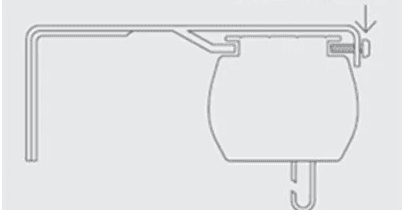
For 89mm vertical blinds, the distance from the back of the bracket to the front of the vane when tilted open is approximately 10.5-12cm.
For 127mm vertical blinds, the depth of the blind when fitted is larger than the standard 89mm blind, requiring greater clearance for vane rotation. The measurement from the back of the bracket to the front of the vane when tilted open is approximately 13.5-15cm.
Please note that these measurements may vary depending on the headrail chosen and the placement of the vane hook within the tracks. For accurate specifications tailored to your chosen fabric and headrail, please contact our customer service team.
- Face Fix Brackets for 89mm blinds are approximately 74mm by 34mm.
- Face Fix Brackets for 127mm blinds are approximately 95mm by 34-51mm.
- Face Fix Brackets for 89mm blinds are approximately 74mm by 34mm.
- Face Fix Brackets for 127mm blinds are approximately 95mm by 34-51mm.
Take the vanes and hook them onto the pegs, ensuring that the pegs are in the open position.
To ensure the safety and integrity of the vertical vanes during transportation, they are packed together and rolled into a tight spiral, with the weights and chains kept separately. This packaging method prevents creasing from the weights and provides additional protection.
Upon unravelling the vanes, they may not be perfectly straight initially. To rectify this, allow the vanes to hang after attaching the weights for a few days. If you still encounter issues with the straightness of the vanes, please reach out to us, and we will assist you in resolving the matter.


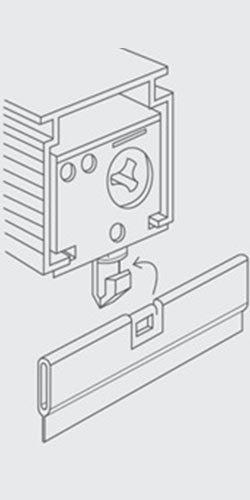
After fitting the headrail and the safety clip, insert the bottom weights into the vertical slat pocket. Ensure that the weight is positioned with the mini-connector ear at the top. This configuration helps maintain proper alignment and functionality of the blinds.

The chain may arrive as one long piece, uncut. Simply cut it where the vanes part, or where the blind finishes, depending on whether you’ve chosen a split stack or a left or right stack configuration. This ensures that the chain fits neatly and functions properly with your vertical blinds.

If you’ve selected a rod-controlled vertical blind, you’ll utilize the wand located at the front of the vane bunch to draw the vanes across the window. This depends on your choice of rod bunch side.
For instance, if you opt for a left-hand bunch, the rod is situated at the front and pulls the vanes from right to left, bringing them across the window. The rod will be positioned on the left side, allowing you to tilt the vanes open or shut to your preference.
In the case of a split bunch selection, the two rods, still positioned at the front of the vane bunches, will converge in the middle when the vanes are drawn across.
Furthermore, the same rod is used to tilt the vanes open simply by twisting it. This functionality provides convenient control over the orientation of the vanes to adjust the light and privacy levels as desired.


If any of the vanes are out of alignment, follow these steps to correct them:
- Pull the chain in one direction until you encounter resistance.
- Apply additional force to the chain in the same direction. You may hear a grinding noise, which is normal.
- Continue pulling forcefully in the same direction. This action should initiate the alignment process, causing the hook pegs or trucks in the headrail to start aligning.
- Once you feel the alignment beginning, repeat the above steps in the opposite direction. This should complete the alignment process, ensuring all hook pegs or trucks are fully aligned.

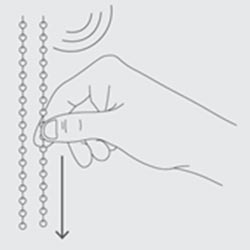

If any of the vanes are out of alignment, follow these steps to correct them:
- Twist the rod until the vanes are in the closed position.
- Continue twisting the rod until all the vanes are aligned.
- Continue pulling forcefully in the same direction. This action should initiate the alignment process, causing the hook pegs or trucks in the headrail to start aligning.
- Once you feel the alignment beginning, repeat the above steps in the opposite direction. This should complete the alignment process, ensuring all hook pegs or trucks are fully aligned.

- Cordless Options: Whenever possible, choose cordless vertical blinds to eliminate the risk of entanglement. Cordless options provide a safer environment for children by removing hazardous cords.
- Cord Safety Devices: If corded blinds are necessary, ensure they are equipped with appropriate safety devices such as tensioners, cord cleats, or cord stops. These devices keep cords out of reach of children and prevent them from forming dangerous loops.
- Keep Cords Out of Reach: Regularly inspect vertical blinds and ensure cords or chains are kept out of reach of children. Shorten cords or use tie-downs to secure them safely away from children’s reach.
- Install High or Concealed Fixtures: Mount vertical blinds high on the wall or use concealed fixtures to prevent children from accessing cords or chains.
- Vane Safety: Ensure that the vanes of vertical blinds are securely attached and not easily removable by children. Loose or detachable vanes can pose a choking hazard.
- Regular Maintenance: Regularly inspect vertical blinds for signs of wear or damage. Replace broken or frayed cords promptly to prevent accidents.
